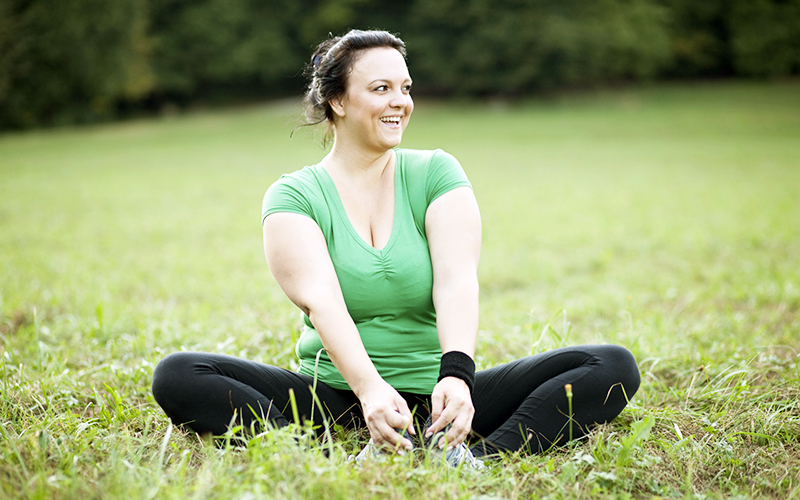
by guest blogger Greg Hoak, MS, CSCS
Even after being a personal trainer for nearly 15 years, starting with a new client is still always exciting for me. Over the years, I’ve worked with people of all ages and fitness levels, from professional MMA fighters to hardworking stay-at-home moms and busy business executives. Increasingly, no matter who they are, losing weight and body fat are my clients’ top goals.
Breaking the Brainwashing Cycle
You’d think training would start with hopping on the treadmill or grabbing a set of weights after a fitness evaluation. But the truth is, I spend a good deal of time managing the person’s expectations and trying to undo weight-loss lies and misconceptions propagated in the media.
Unfortunately (for both of us), a lifetime of sensationalized headlines and late-night miracle weight-loss infomercials means devoting a lot of time to disentangling the hype to help get a person mentally started on the right track.
Often, popular weight-loss programs set an expectation of hard work at high intensity leading to fast results. Get-fit-fast products aren’t always the best (or safest) way for the average adult to lose weight, and in my opinion they have caused many individuals to enter the cycle of high-intensity burnout.
On the other hand, some TV shows chronicle the lives of people who completely abandoned their daily lives to “live in the gym” or on the training course. These are extreme examples that are often touted as success stories on Facebook or Twitter. However, you don’t need to give up your entire life to get fit and lose weight. The truth is, it is possible for a busy individual with many responsibilities to get the job done simply by making reasonable sacrifices.
I tailor fitness programs to the individual, and you should do the same for yourself.
If you have an extreme personality, try some of the high-intensity workouts. But if find you’re trying to lose weight and failing over and over, it’s probably time to try something else. The safest and most sustainable programs are moderate in intensity and include fun.
It’s a cliché, I know, but I find myself saying this to my clients a lot: You can’t sprint a marathon. Whether they know it or not, committing to training with me is signing up for the longest run of their lives.
Every person faces unique challenges to starting and maintaining a healthy life change. The best advice I can give to you without knowing your specific challenges is try something new and take it nice and slow in the beginning.
Getting the Weight-Loss Ball Rolling
There are many ways kick-start your new long-term fitness journey. The following are three of my top tips that have helped some of my clients reach incredible milestones over time.
1. Don’t be brainwashed! How much weight is good healthy weight loss? Two pounds a week, right? NO. It depends on your starting weight, your base metabolism, genetics, and so many other factors.
Even if you lose a half-pound a week for 52 weeks, you’ll lose 26 pounds in a year. That’s huge! Especially considering that any added strength you’ve gained over the year is from metabolism-revving lean muscle.
Now compare that to what you did last year not exercising. You have to take the long view if you’re going to make sustainable (and long-lasting) changes to your health. Of course results could come faster, but even a moderate result is something that can change your life. Remember, it’s not a sprint. A recent study found people who run slower actually tend to live longer.
2. Think about weight in kilos. Know that the first step is the longest and hardest. This is especially true when starting a healthy lifestyle change—especially when the first step involves getting on the scale. As a trainer, I used to tell my clients that it was OK to avoid the scale, telling them they could judge shifts in weight by how their clothing fit. For some, I still take that approach in the beginning, but only at the beginning.
The truth is that there is a lot of psychology behind why people have a hard time stepping on the scale—we don’t have the space to cover it all in this article. But you can’t let it be a brick wall.
Instead, use this trick to get over your fear: Weigh yourself in kilograms.
Although it’s temporarily painful for some, getting on the scale is often a necessary evil to create the stark accountability necessary for making monumental life changes.
To take away the stigma of “the number,” most of my clients weigh in using kilograms, not pounds. Most scales have a small button on the bottom that switches from pounds to kilograms. That small flick of the switch has been a simple, powerful way to help people I work with track and share their weight with me on a weekly basis without obsessing over pounds. This simple habit has the power to lead to impressive, long-lasting results.
3. Find the necessary level of accountability, then get texting. Weighing in works. Texting does, too. In my experience, more communication equals better weight-loss results. Find a mentor and set up text message accountability. I have most of my clients text me their weight in kilograms once a week. This serves the purpose of making them more mindful. Most bad habits that lead to weight gain are the actions of your subconscious—for instance, food binges that occur when you’re not paying attention and tapped into the moment.
I keep a current record of weight, making it easy to spot a negative or positive trend immediately. This allows me to make adjustments in the program when necessary. Gaining a kilo or two is only a small problem. Not texting at all signals a bigger problem. When I don’t get the text, it often means the person is in need of greater intervention. Or he or she is choosing consciously not to participate.
The best way to hold yourself accountable is to hire an experienced trainer.
Personal trainers with years of experience are often the best example. I recommend trainers with top-tier certifications, including ones from the American College of Sports Medicine, National Academy of Sports Medicine, and the National Strength and Conditioning Association. And once you’ve gotten started with someone, ask if you can text him or her your kilos every Monday!
 Greg Hoak, MS, CSCS, is the developer of FarmerFit and has been a professional fitness trainer for 12 years. He earned an exercise science degree from Arizona State University and a master’s degree in exercise science from California University of Pennsylvania. He’s trained professional athletes and mixed martial arts fighters, amateur athletes, and everyday people. He’s also a sustainable farmer at Potter’s Farm in Pine Grove, Pennsylvania, where he and his wife run a community-supported agriculture program, growing vegetables and tending to egg-laying hens raised on pasture.
Greg Hoak, MS, CSCS, is the developer of FarmerFit and has been a professional fitness trainer for 12 years. He earned an exercise science degree from Arizona State University and a master’s degree in exercise science from California University of Pennsylvania. He’s trained professional athletes and mixed martial arts fighters, amateur athletes, and everyday people. He’s also a sustainable farmer at Potter’s Farm in Pine Grove, Pennsylvania, where he and his wife run a community-supported agriculture program, growing vegetables and tending to egg-laying hens raised on pasture.




No comments yet.